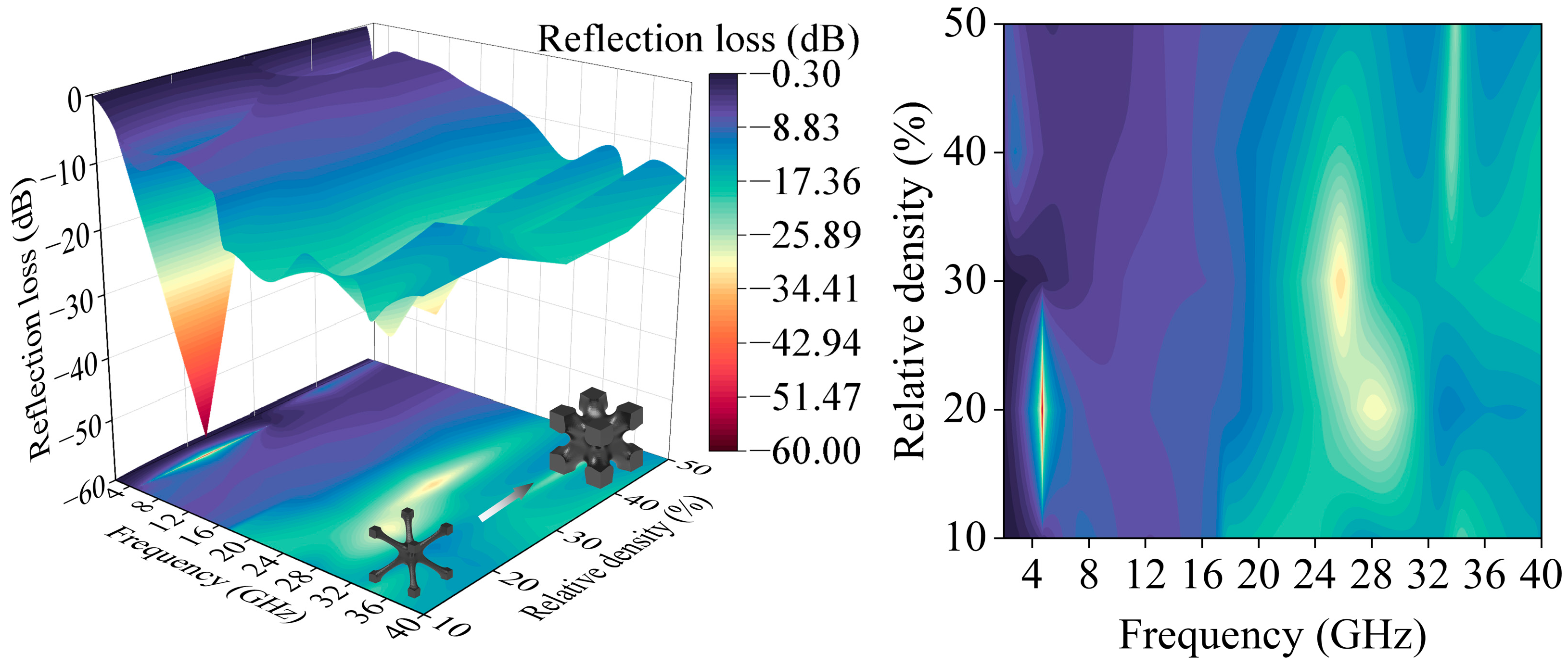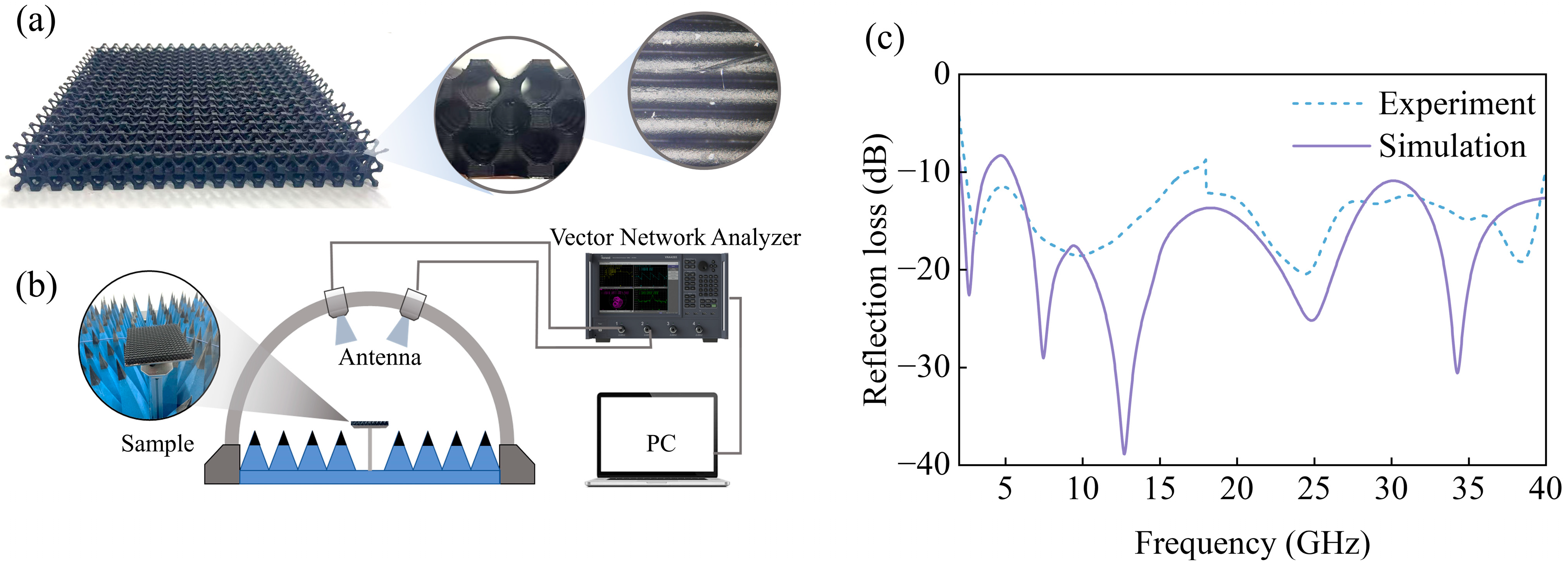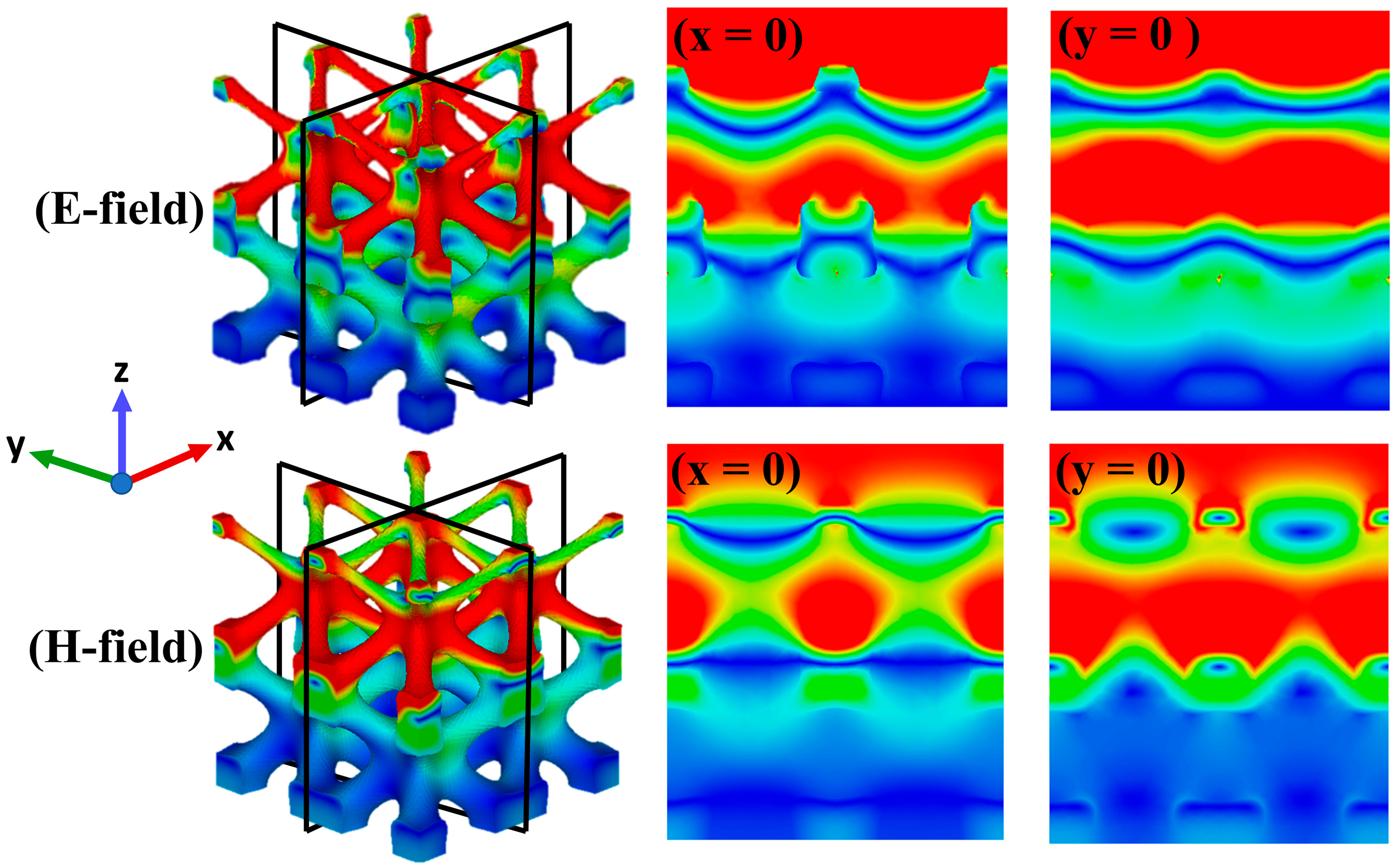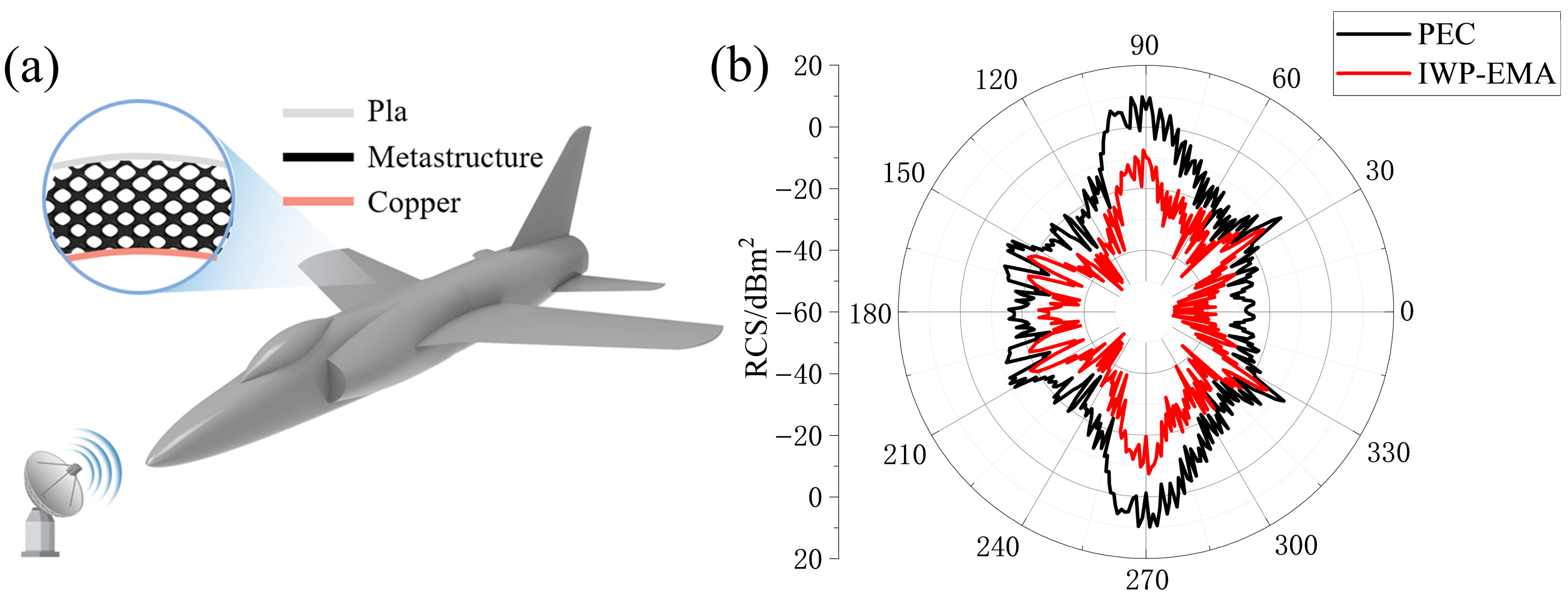Design of I-WP Gradient Metamaterial Broadband Electromagnetic Absorber Based on Additive Manufacturing
Abstract
1. Introduction
2. Materials and Methods
2.1. Materials
2.2. Main Printing Parameters
2.3. Measurement of Electromagnetic Parameters
3. Results and Discussion
3.1. EM-Absorbing Metamaterial Design
3.2. Reflectance Test
3.3. Energy Loss Mechanism
3.4. Angle-Sensitive Properties
3.5. Application Demonstration
4. Conclusions
Author Contributions
Funding
Institutional Review Board Statement
Data Availability Statement
Conflicts of Interest
References
- Zhou, Q.; Qi, C.; Shi, T.; Li, Y.; Ren, W.; Gu, S.; Xue, B.; Ye, F.; Fan, X.; Du, L. 3D printed carbon based all-dielectric honeycomb metastructure for thin and broadband electromagnetic absorption. Compos. Part A Appl. Sci. Manuf. 2023, 169, 107541. [Google Scholar] [CrossRef]
- Liang, H.; Chen, G.; Liu, D.; Li, Z.; Hui, S.; Yun, J.; Zhang, L.; Wu, H. Exploring the Ni 3d Orbital Unpaired Electrons Induced Polarization Loss Based on Ni Single-Atoms Model Absorber. Adv. Funct. Mater. 2022, 33, 2212604. [Google Scholar] [CrossRef]
- Huang, Q.; Wang, G.; Zhou, M.; Zheng, J.; Tang, S.; Ji, G. Metamaterial electromagnetic wave absorbers and devices: Design and 3D microarchitecture. J. Mater. Sci. Technol. 2022, 108, 90–101. [Google Scholar] [CrossRef]
- Wu, Z.; Cheng, H.W.; Jin, C.; Yang, B.; Xu, C.; Pei, K.; Zhang, H.; Yang, Z.; Che, R. Dimensional Design and Core–Shell Engineering of Nanomaterials for Electromagnetic Wave Absorption. Adv. Mater. 2022, 34, 2107538. [Google Scholar] [CrossRef] [PubMed]
- Jiang, B.; Qi, C.; Yang, H.; Wu, X.; Yang, W.; Zhang, C.; Li, S.; Wang, L.; Li, Y. Recent advances of carbon-based electromagnetic wave absorption materials facing the actual situations. Carbon 2023, 208, 390–409. [Google Scholar] [CrossRef]
- Feng, M.; Zhang, K.; Xiao, J.; Liu, B.; Cheng, H.; Li, Y.; Zhao, Z.; Liang, B. Material-structure collaborative design for broadband microwave absorption metamaterial with low density and thin thickness. Compos. Part B Eng. 2023, 263, 110862. [Google Scholar] [CrossRef]
- Yang, X.; Lin, Y.; Huang, Y.; Chen, M. Mechanical Reinforced Lightweight Multifunctional Metastructure With Ultrabroadband Microwave Absorption. IEEE Antennas Wirel. Propag. Lett. 2021, 20, 1023–1027. [Google Scholar] [CrossRef]
- Gao, Q.; Ye, X.; He, E.; Yan, T.; Wang, Y.; Huang, C.; Ye, Y.; Wu, H. 3D printed composites achieve broadband electromagnetic wave absorption by introducing carbon black/carbonyl iron powder porous hollow microspheres. Mater. Sci. Eng. B 2024, 299, 116937. [Google Scholar] [CrossRef]
- Rubežienė, V.; Varnaitė-Žuravliova, S.; Sankauskaitė, A.; Pupeikė, J.; Ragulis, P.; Abraitienė, A. The Impact of Structural Variations and Coating Techniques on the Microwave Properties of Woven Fabrics Coated with PEDOT:PSS Composition. Polymers 2023, 15, 4224. [Google Scholar] [CrossRef] [PubMed]
- Lee, J.; Lim, D.D.; Park, J.; Lee, J.; Noh, D.; Gu, G.X.; Choi, W. Multifunctionality of Additively Manufactured Kelvin Foam for Electromagnetic Wave Absorption and Load Bearing. Small 2023, 19, 2305005. [Google Scholar] [CrossRef] [PubMed]
- Feng, J.; Qiao, J.; Xu, Q.; Zhang, G.; Li, L. Accelerated design of acoustic-mechanical multifunctional metamaterials via neural network. Int. J. Mech. Sci. 2025, 287, 109920. [Google Scholar] [CrossRef]
- Feng, J.; Qiao, J.; Xu, Q.; Wu, Y.; Zhang, G.; Li, L. Broadband Sound Absorption and High Damage Resistance in a Turtle Shell-Inspired Multifunctional Lattice: Neural Network-Driven Design and Optimization. Small 2024, 20, 2403254. [Google Scholar] [CrossRef] [PubMed]
- Zhang, Y.; Zhang, G.; Qiao, J.; Li, L. Design and In Situ Additive Manufacturing of Multifunctional Structures. Engineering 2023, 28, 58–68. [Google Scholar] [CrossRef]
- Lim, D.D.; Park, J.; Lee, J.; Noh, D.; Lee, J.; Choi, J.; Choi, W. Broadband mechanical metamaterial absorber enabled by fused filament fabrication 3D printing. Addit. Manuf. 2022, 55, 2403254. [Google Scholar] [CrossRef]
- Yin, M.; Tian, X.Y.; Wu, L.L.; Li, D.C. A Broadband and omnidirectional electromagnetic wave concentrator with gradient woodpile structure. Opt. Express 2013, 21, 19082–19090. [Google Scholar] [CrossRef] [PubMed]
- Sun, C.; Li, D.; Liu, T.; An, Q.; Zhang, C.; Li, Y.; Liao, W. Design of functionally gradient metastructure with ultra-broadband and strong absorption. Compos. Part B Eng. 2024, 280, 111484. [Google Scholar] [CrossRef]
- Jiang, W.; Yan, L.; Ma, H.; Fan, Y.; Wang, J.; Feng, M.; Qu, S. Electromagnetic wave absorption and compressive behavior of a three-dimensional metamaterial absorber based on 3D printed honeycomb. Sci. Rep. 2018, 8, 4817. [Google Scholar] [CrossRef] [PubMed]
- Duan, Y.; Liang, Q.; Yang, Z.; Li, Z.; Yin, H.; Cao, Y.; Li, D. A wide-angle broadband electromagnetic absorbing metastructure using 3D printing technology. Mater. Des. 2021, 208, 109900. [Google Scholar] [CrossRef]
- Guo, X.; Li, X.; Wang, E.; Fuh, J.Y.H.; Lu, W.F.; Zhai, W. Bioinspired hierarchical diamond triply periodic minimal surface lattices with high energy absorption and damage tolerance. Addit. Manuf. 2023, 76, 103792. [Google Scholar] [CrossRef]
- Zhang, J.; Chen, X.; Sun, Y.; Wang, Y.; Bai, L. Sound-absorption and mechanical properties of multisheet Gyroid lattice structures by stereolithography. Compos. Struct. 2023, 325, 117589. [Google Scholar] [CrossRef]
- Tang, Y.; Xin, F.; Lu, T.J. Sound absorption of micro-perforated sandwich panel with honeycomb-corrugation hybrid core at high temperatures. Compos. Struct. 2019, 226, 111285. [Google Scholar] [CrossRef]
- Yu, S.; Wang, C.; Chen, Z.; Qiu, Z.; Chu, C.; Cheng, Y.; Zeng, T.; Sun, A. Additive manufacturing of broadband electromagnetic wave absorbing materials: Polymer-derived SiC/Si3N4 composites with triply periodic minimal surface meta-structure. Chem. Eng. J. 2024, 483, 149185. [Google Scholar] [CrossRef]
- Xing, R.; Xu, G.; Qu, N.; Zhou, R.; Yang, J.; Kong, J. 3D Printing of Liquid-Metal-in-Ceramic Metamaterials for High-Efficient Microwave Absorption. Adv. Funct. Mater. 2023, 34, 2307499. [Google Scholar] [CrossRef]
- An, Q.; Li, D.; Liao, W.; Liu, T.; Joralmon, D.; Li, X.; Zhao, J. A Novel Ultra-Wideband Electromagnetic-Wave-Absorbing Metastructure Inspired by Bionic Gyroid Structures. Adv. Mater. 2023, 35, 2300659. [Google Scholar] [CrossRef] [PubMed]
- Abu Al-Rub, R.K.; Lee, D.-W.; Khan, K.A.; Palazotto, A.N. Effective Anisotropic Elastic and Plastic Yield Properties of Periodic Foams Derived from Triply Periodic Schoen’s I-WP Minimal Surface. J. Eng. Mech. 2020, 146, 04020030. [Google Scholar] [CrossRef]
- Al-Ketan, O.; Al-Rub, R.K.A.; Rowshan, R. Mechanical Properties of a New Type of Architected Interpenetrating Phase Composite Materials. Adv. Mater. Technol. 2016, 2, 1600235. [Google Scholar] [CrossRef]
- Zhou, Q.; Yin, X.; Ye, F.; Liu, X.; Cheng, L.; Zhang, L. A novel two-layer periodic stepped structure for effective broadband radar electromagnetic absorption. Mater. Des. 2017, 123, 46–53. [Google Scholar] [CrossRef]
- Smith, D.R.; Vier, D.C.; Koschny, T.; Soukoulis, C.M. Electromagnetic parameter retrieval from inhomogeneous metamaterials. Phys. Rev. E 2005, 71, 036617. [Google Scholar] [CrossRef] [PubMed]
- Jiang, X.; Cai, G.; Song, J.; Zhang, Y.; Yu, B.; Zhai, S.; Chen, K.; Zhang, H.; Yu, Y.; Qi, D. Large-Scale Fabrication of Tunable Sandwich-Structured Silver Nanowires and Aramid Nanofiber Films for Exceptional Electromagnetic Interference (EMI) Shielding. Polymers 2023, 16, 61. [Google Scholar] [CrossRef] [PubMed]
- Wang, J.; Wu, W.; Zhang, W.; Zhao, Y.; Wang, H.; Yuan, S.; Zhang, J. Synthesis, Electrical Conductivity, and Wave-Absorption Performances of Bamboo-Based Composites Co-Doped with Graphene Oxide and Polyaniline. Polymers 2024, 17, 78. [Google Scholar] [CrossRef] [PubMed]
- Tsyhanok, D.; Meisak, D.; Blyweert, P.; Selskis, A.; Macutkevič, J.; Banys, J.; Fierro, V.; Celzard, A. Investigating 3D-Printed Carbon–Carbonyl Iron Composites for Electromagnetic Applications. Polymers 2025, 17, 1009. [Google Scholar] [CrossRef] [PubMed]
- Antunes, M. Recent Trends in Polymeric Foams and Porous Structures for Electromagnetic Interference Shielding Applications. Polymers 2024, 16, 195. [Google Scholar] [CrossRef] [PubMed]
- An, Q.; Li, D.; Liao, W.; Liu, T.; Qu, Z.; Wang, G.; Li, X. Electromagnetic Absorption Mechanism of TPMS-Based Metastructures: Synergy Between Materials and Structures. Adv. Funct. Mater. 2024, 35, 2414629. [Google Scholar] [CrossRef]








| Structure | Re(MAD) | Im(MAD) |
|---|---|---|
| 20% | 0.3208 | 0.3900 |
| 20–20% | 0.3182 | 0.3539 |
| 10–30% | 0.2426 | 0.2488 |
Disclaimer/Publisher’s Note: The statements, opinions and data contained in all publications are solely those of the individual author(s) and contributor(s) and not of MDPI and/or the editor(s). MDPI and/or the editor(s) disclaim responsibility for any injury to people or property resulting from any ideas, methods, instructions or products referred to in the content. |
© 2025 by the authors. Licensee MDPI, Basel, Switzerland. This article is an open access article distributed under the terms and conditions of the Creative Commons Attribution (CC BY) license (https://creativecommons.org/licenses/by/4.0/).
Share and Cite
Qin, Y.; Kang, Y.; Liu, H.; Feng, J.; Qiao, J. Design of I-WP Gradient Metamaterial Broadband Electromagnetic Absorber Based on Additive Manufacturing. Polymers 2025, 17, 1990. https://doi.org/10.3390/polym17141990
Qin Y, Kang Y, Liu H, Feng J, Qiao J. Design of I-WP Gradient Metamaterial Broadband Electromagnetic Absorber Based on Additive Manufacturing. Polymers. 2025; 17(14):1990. https://doi.org/10.3390/polym17141990
Chicago/Turabian StyleQin, Yi, Yuchuan Kang, He Liu, Jianbin Feng, and Jianxin Qiao. 2025. "Design of I-WP Gradient Metamaterial Broadband Electromagnetic Absorber Based on Additive Manufacturing" Polymers 17, no. 14: 1990. https://doi.org/10.3390/polym17141990
APA StyleQin, Y., Kang, Y., Liu, H., Feng, J., & Qiao, J. (2025). Design of I-WP Gradient Metamaterial Broadband Electromagnetic Absorber Based on Additive Manufacturing. Polymers, 17(14), 1990. https://doi.org/10.3390/polym17141990






